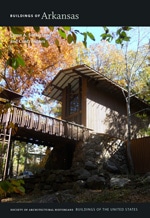Clarksville was designated the county seat in 1836, three years after the county was created, and this courthouse, the county’s third on the site, was designed by a Fort Smith firm and built by contractors Linebarger and Fraser. The three-story building is in many ways typical of WPA-funded Classical Revival courthouse designs with its three stories, buff-colored masonry exterior, round-arched windows illuminating the first floor, and a row of two-story high Ionic columns emphasizing the upper stories. The courtroom, which is on the second floor, is lavish with dark-stained woodwork and ornately carved pilasters and broken pediments. The courthouse remains one of the county’s grandest buildings constructed during the Great Depression.
You are here
Johnson County Courthouse
If SAH Archipedia has been useful to you, please consider supporting it.
SAH Archipedia tells the story of the United States through its buildings, landscapes, and cities. This freely available resource empowers the public with authoritative knowledge that deepens their understanding and appreciation of the built environment. But the Society of Architectural Historians, which created SAH Archipedia with University of Virginia Press, needs your support to maintain the high-caliber research, writing, photography, cartography, editing, design, and programming that make SAH Archipedia a trusted online resource available to all who value the history of place, heritage tourism, and learning.


